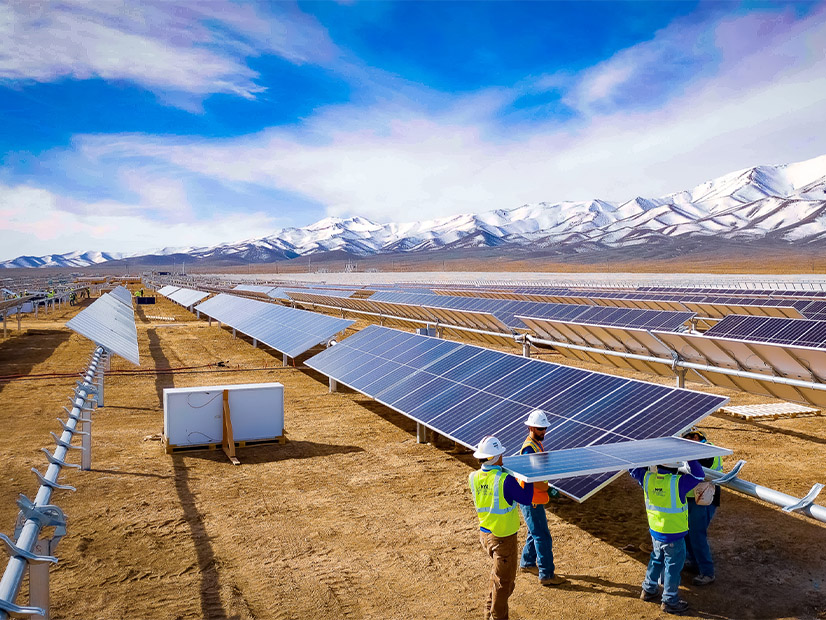
NV Energy exceeded Nevada’s renewable portfolio standard requirement of 24% in 2021, with nearly 31% of its retail energy sales coming from renewable resources and related credits, according to a report approved by state regulators last week.
NV Energy subsidiary Sierra Pacific Power, which serves northern Nevada, achieved 31.9% renewable energy last year. Southern Nevada subsidiary Nevada Power reached 30.1% renewable energy. The statewide weighted average was 30.7%, according to the report filed by the utility in April.
Last year’s adjusted retail sales were 8,728,248 MWh for Sierra Pacific and 20,712,404 MWh for Nevada Power.
The Public Utilities Commission of Nevada (PUCN) voted 3-0 on Tuesday to approve the report and confirm that NV Energy complied with the 2021 renewable portfolio standard.
50% by 2030
Nevada’s RPS was 24% last year, an increase from 22% in 2020. The RPS grows to 29% in 2022 and 2023; 34% in 2024 through 2026; 42% in 2027 through 2029; and 50% in 2030. NV Energy said it is “well on its way” to meeting the 50% renewable requirement by 2030.
“Our commitment to evolving our generation mix is one of many ways we are helping meet our state’s sustainability goals,” Dave Ulozas, NV Energy’s senior vice president of energy supply, renewables and origination, said in a release shortly after the utility filed its report with PUCN.
Last year was the 12th year in a row that the company surpassed the state’s renewable energy requirement, the release said.
DSM, Carryovers
Under Nevada statute, energy efficiency measures may count toward up to 10% of the annual RPS requirement, through 2024. After that, energy efficiency measures — included within demand side management (DSM) — can’t be used toward meeting the standard.
NV Energy used energy savings from DSM to satisfy 10% of its RPS requirements last year.
In addition, the utility used excess portfolio credits carried over from 2020 to help meet last year’s RPS requirement. And surplus credits from last year will be carried over to this year.
State law allows a utility to sell excess portfolio credits when the surplus is more than 10% of the required amount. If the surplus is more than 25% of the amount needed to meet the RPS, the utility is directed to “use reasonable efforts to sell” credits in excess of 25%.
Sierra Pacific went over the 25% threshold with its surplus portfolio credits and solicited offers to buy them. Although the utility received seven offers, it ultimately decided to keep the credits in case it needs them later, according to the report.
Nevada Power had surplus portfolio credits in the 10% to 25% range. NV Energy said it would consider selling the credits “if the circumstances are favorable and the sale benefits our customers.”
New Solar Projects
At the end of 2021, Nevada Power had about 1,570 MW of renewable generation capacity in service, according to NV Energy’s filing. Nevada Power added one utility-scale renewable project last year, Copper Mountain 5, a 250 MW solar facility in Boulder City.
In addition, Nevada Power had nine solar projects totaling 2,044 MW in development at the end of last year. Eight of those projects include battery storage.
Sierra Pacific finished the year with about 692 MW of renewable capacity in operation. During 2021, one new project was added: the 101 MW Battle Mountain solar facility, which includes 25 MW of storage.
The utility also had six solar projects with a combined total of 824 MW in development at the end of the year. All the projects include battery storage.
NV Energy’s filing described a “positive” outlook for both of its subsidiaries to comply with the RPS and other future credit commitments.
However, the utility noted some risks. In particular, delays in receiving solar panels and other project components are causing project completion dates to be pushed back and could result in project cancellations, the RPS report said.
“Delays and shortages can drive up costs to a point where a project that was previously economical becomes uneconomical,” NV Energy said.
